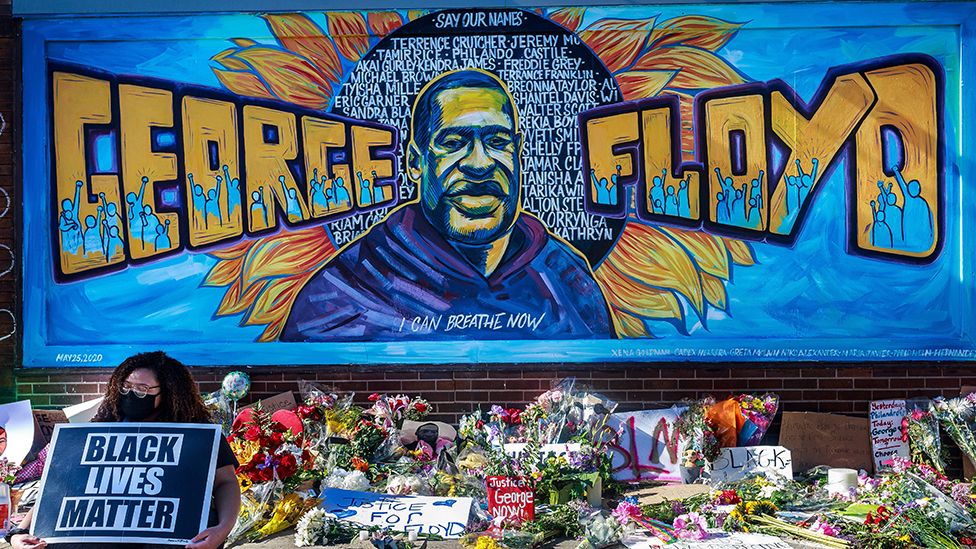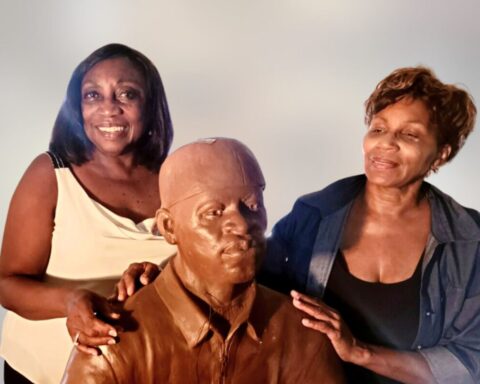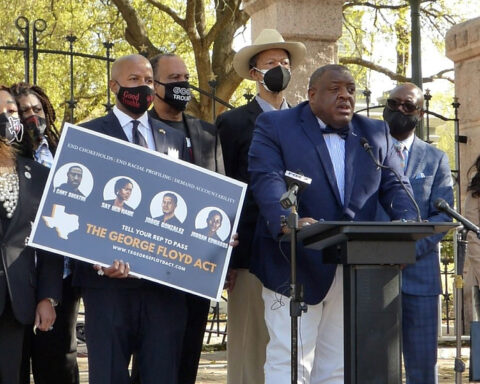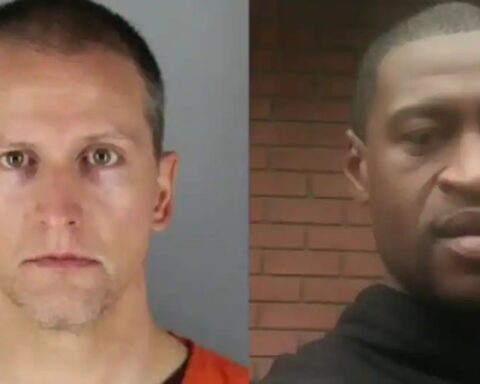A renowned pulmonary critical care doctor testified Thursday morning that George Floyd died from a “low level of oxygen” when former police officer Derek Chauvin pinned him to the street and restricted his ability to breathe.
“This caused damage to his brain that we see, and it also caused a PEA arrhythmia that caused his heart to stop,” Dr. Martin Tobin of Chicago testified, referring to pulseless electrical activity, a type of cardiac arrest.
“The cause of the low level of oxygen was shallow breathing,” he added. “Small breaths. Small tidal volumes. Shallow breaths that weren’t able to carry the air through his lungs down to the essential areas of the lungs that get oxygen into the blood and get rid of the carbon dioxide.”
He identified four main reasons why Floyd died: the handcuffs and the street acting as a “vise;” Chauvin’s left knee on his neck; Floyd’s prone position; and Chauvin’s right knee on Floyd’s back, arm and side. Combined, these limited Floyd’s ability to expand his lungs and narrowed his hypopharynx, a part of the throat that air passes through.
Floyd’s preexisting health conditions and drug use were not relevant to his death, Tobin said.
“A healthy person subjected to what Mr. Floyd was subjected to would have died,” he said.
Tobin’s testimony came on the ninth day of the trial as prosecutors shifted into the third phase of their case, focusing on the medical analysis of Floyd’s cause of death. Also on Thursday, another doctor seconded Tobin’s conclusion and a forensic toxicologist discussed the drugs found in Floyd’s system.
The first week of the trial focused on Floyd’s last moments on May 25, 2020, particularly the harrowing bystander and body-camera footage that showed his final breaths. Over the last few days, a series of police experts and training coordinators have testified that Chauvin violated police policy and used excessive force on Floyd.
The medical analysis is important to the prosecution’s case that Chauvin was a substantial cause of Floyd’s death when he put his body weight on Floyd’s neck and back for over nine minutes — causing death by “positional asphyxia.” Chauvin’s defense attorney Eric Nelson has argued that Floyd died of a drug overdose and preexisting health conditions.
Chauvin, 45, has pleaded not guilty to second-degree unintentional murder, third-degree murder and second-degree manslaughter. The trial, now in its second full week of testimony, is expected to last about a month.
Floyd used knuckles to try to breathe, doctor says
Dr. Tobin highlighted several still images from the police body-cam footage that showed Floyd pressing his knuckles against the squad car’s tire, pressing his fingers and knuckles against the ground, lifting his right shoulder and even digging his face into the street. These images indicated that Floyd was using every possible way to try to lift up his chest and breathe, Tobin said.
“It’s a very poor way of breathing. But it’s what you have to do when everything else is failing,” he said.
Prosecutors also played disturbing slow-motion video of what Tobin said was Floyd’s final moment alive, as his eyes flickered and then closed.
“You can see his eyes, he’s conscious, and then you see that he isn’t. That’s the moment the life goes out of his body,” Tobin said.
By observing Floyd’s condition in video and calculating the rate of decline in his blood-oxygen level, Tobin deduced that Floyd eventually had no oxygen left in his body. Chauvin remained kneeling on him for another three minutes and two seconds after that point, he said.
He highlighted a moment in the body-camera footage when Floyd’s legs lift into the air. This involuntary movement, also known as an anoxic seizure, is evidence of a fatal brain injury due to lack of oxygen, Tobin said.
With the demeanor of a kindly old professor, Tobin — who wrote the textbook on mechanical ventilation — spoke directly to the jury and encouraged them to feel parts of their own neck and chest as he described how breathing works. Almost all of the jurors did as the doctor asked and closely engaged with the testimony, according to a pool report from inside the courtroom.
Chauvin kneeled for over 3 minutes after Floyd had no oxygen in his body
Chauvin’s knee was on Floyd’s neck for over 90% of the time, Tobin said. The doctor calculated that this constituted about 91.5 pounds on Floyd’s neck when his feet came off the ground.
Further, Tobin explained that fentanyl did not play a role in Floyd’s death. After observing body-cam footage, Tobin calculated Floyd’s respiratory rate at 22 breaths per minute, within normal range. People who overdose on fentanyl generally have a respiratory rate of about 10, so Tobin concluded that fentanyl was not affecting Floyd’s breathing.
“Basically it tells you that there isn’t fentanyl on board that is affecting his respiratory centers. It’s not having an effect on his respiratory centers,” Tobin said.
At the scene, former officer Tou Thao told the concerned bystanders that “if you can speak, you can breathe.” Tobin testified that comment is true but misleading and “gives you an enormous false sense of security.”
“Certainly, at the moment that you are speaking, you are breathing. But it doesn’t tell you that you’re going to be breathing five seconds later,” the doctor said.
On cross-examination, defense attorney Nelson, his voice growing hoarse, said he had only received Tobin’s medical reports the night before. He struggled to make much headway against Tobin’s expertise, though he did get Tobin to acknowledge that fentanyl’s peak effect is about five minutes after ingestion.
The most important medical testimony could come Friday when Hennepin County Chief Medical Examiner Dr. Andrew Baker is expected to testify. Baker performed the autopsy on Floyd and determined his death was a homicide, listing the cause of death as “cardiopulmonary arrest complicating law enforcement subdual, restraint, and neck compression.”
However, Tobin indicated the autopsy may not be of much use in this case. Deaths from low oxygen don’t “leave a fingerprint” on an autopsy, he said.
Second doctor rejects excited delirium
Dr. Bill Smock, an emergency medicine physician and the police surgeon for the Louisville Metro Police, testified Thursday for the prosecution as a medical expert. He seconded Dr. Tobin’s analysis of Floyd’s cause of death.
“Mr. Floyd died from positional asphyxia, which is a fancy way of saying he died because he had no oxygen left in his body,” he said.
Smock rejected the idea that Floyd died of “excited delirium,” a controversial diagnosis that is not recognized by either the American Psychiatric Association or the American Medical Association. Smock said he believes it is a real diagnosis — but Floyd showed none of its 10 symptoms, such as taking off his clothes or failing to respond to questions.
He similarly rejected the theory that Floyd died of a fentanyl overdose. People who overdose on fentanyl become listless and stop breathing, while Floyd was desperately trying to breathe.
“That is not a fentanyl overdose. That is somebody begging to breathe,” he said.
Toxicologists testify on drugs in Floyd’s system
Daniel Isenschmid, a forensic toxicologist at NMS Labs who analyzed Floyd’s blood, testified Thursday afternoon about the levels of drugs found in Floyd’s blood after his death.
Testing found that Floyd had about 11 nanograms per milliliter of fentanyl in his blood. That is comparable to the level found in people arrested for DUI, but lower than the level found in people tested after death, Isenschmid said. The impact of fentanyl on someone can vary from person to person due to tolerance, he said.
Floyd also had 19 nanograms per milliliter of methamphetamine in his system, a “very low” level, according to Isenschmid.
A day earlier, jurors heard testimony that several white pills containing fentanyl and methamphetamine were found in Floyd’s vehicle, and a smaller pill with Floyd’s saliva on it was found in the back of the police squad car.
Correction: A previous version of this story misstated the charges Derek Chauvin faces in George Floyd’s death. They are second-degree unintentional murder, third-degree murder and second-degree manslaughter. He has pleaded not guilty.







